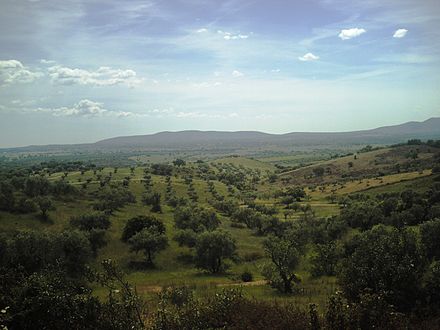Alentejo - NUTS II designated region of Portugal
The Alentejo is a beautiful, mostly agricultural, region remarkable for its wide horizons, filled with soft hills that change color along the year, from deep brown to green with white, red and purple, to golden. Sunsets and the light play are stunning. As the warmest region in Portugal, its inhabitants are known for their slow-paced, easy-going lifestyle and song-like accent, that are in great harmony with the Alentejo's calm-inducing topography. So, if you are there, do like the Alentejanos, and do it slowly. No stress, please.
The main city is Évora, in Alto Alentejo, with historic monuments, churches and museums. It was one of the development centers of early European megalithism (standing stones).
Regions

Cities
- Évora 📍 — , regional capital, district capital, university city with several museums and Roman temple ruins at the top of a commanding hill
- Alcácer do Sal — a very old town on top of a hill, by the Sado river. The municipality includes the seaside village of Comporta, gateway to wildlife reserves and white sandy beaches.
- Beja 📍 — historic city, district capital
- Castelo de Vide 📍 — a beautiful fortified castle town on an adorable mount
- Elvas 📍 — , a very historic city near Guadiana river, across from Badajoz
- Estremoz 📍 — one of the "three marble towns" of Alentejo, with a marble castle
- Marvão 📍 — another beautiful castle town, perched on a craig
- Odemira — the largest municipality in Portugal by area. It includes the fishing village of Zambujeira do Mar with fine sandy beaches and traditional architecture; it is part of the Nature Park of the Southwest Alentejo.
- Santiago do Cacém 📍 — it has Roman ruins, a Moorish castle, and a 13th-century church
Other destinations
Understand
The Alentejo (uh-lehn-TAY-zhoo, /ɐ.ɫẽ.ˈtɐj.ʒu/, meaning "beyond the Tagus River") is mostly rural, with some urban areas. It's generally hotter than other parts of Portugal.
Get in
Get around
Most places may be reached by bus from Evora but for some of the mountain areas including Marvão and Castelo de Vide you will need to get first to Portalegre. For more information, check Rodoviária do Alentejo and Transportes Intermunicipal do Baixo Alentejo.
See

- Elvas fortress system
- Alqueva Dam on the Guadiana near Portel.
- Marble structures in the three "marble towns" of Estremoz, Borba and Vila Viçosa.
- Megalithic monuments — More than 1000 are found in Alentejo, of which the most important can be visited.
- Neolithic ruins — Cave paintings and Stonehenge-era structures are scattered across the countryside near Évora.
Do
- The west coast is one of the most beautiful beach zones, that has (so far) survived without the extensive tourism industry that affected the Algarve. Be sure to visit Vila Nova de Mil-Fontes or one of the little towns around.
- In the summer (august), if you are a rock fan, try to catch the Sudoeste Rock Festival, near Zambujeira.
- Don't miss the beautiful village of Marvão, with its wonderful castle and fantastic museum.
- Évora is a world Heritage place. Don't miss it!
Eat
Drink
Wines from the Alentejo region are very popular among the Portuguese people, so take the chance to know them!
The local drink, the production of which used to be illegal, is a form of liqueur called medronho, made from the small, round, red fruit of the same name. It is very strong and should be sipped, rather than gulped.
Among all the Alentejo region you will find a lot of wonderful places to stay.
Stay safe
Avoid extreme heat in Summer.
Go next
- Algarve — popular beach and resort region to the south
- Beiras — Portugal's central region to the north
- Castelo Branco — cathedral city with a Templar castle
- Extremadura – a region of Spain
- Faro — capital of the Algarve
- Huelva — a province in Spain's Andalusia region
- Lisboa — Portugal's capital city
- Tagus Valley — region to the northwest
- Tomar — city famous for its connections with the Knights Templar

-Nelson_Ricardo_2500-Alentejo.wav/440px-LL-Q5146_(por)-Nelson_Ricardo_2500-Alentejo.wav)